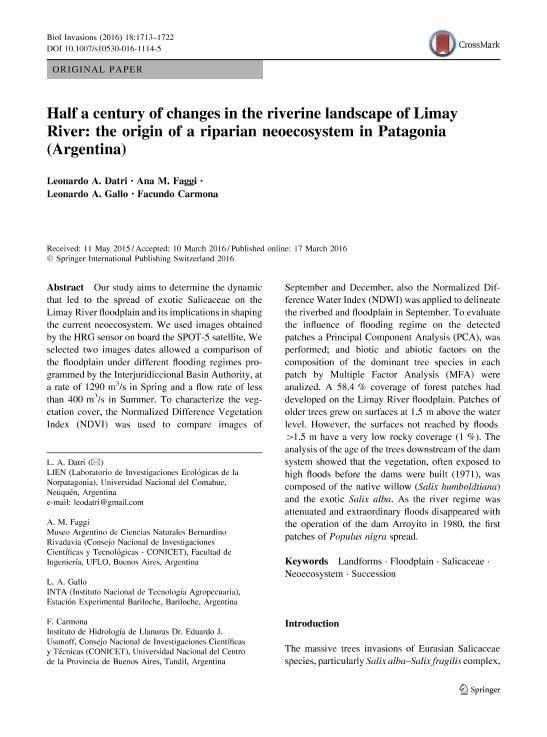Mostrar el registro sencillo del ítem
dc.contributor.author
Datri, Leonardo Ariel

dc.contributor.author
Faggi, Ana Maria

dc.contributor.author
Gallo, Leonardo Ariel
dc.contributor.author
Carmona, Facundo

dc.date.available
2018-06-21T17:44:28Z
dc.date.issued
2016-06
dc.identifier.citation
Datri, Leonardo Ariel; Faggi, Ana Maria; Gallo, Leonardo Ariel; Carmona, Facundo; Half a century of changes in the riverine landscape of Limay River: the origin of a riparian neoecosystem in Patagonia (Argentina); Springer; Biological Invasions; 18; 6; 6-2016; 1713-1722
dc.identifier.issn
1387-3547
dc.identifier.uri
http://hdl.handle.net/11336/49577
dc.description.abstract
Our study aims to determine the dynamic that led to the spread of exotic Salicaceae on the Limay River floodplain and its implications in shaping the current neoecosystem. We used images obtained by the HRG sensor on board the SPOT-5 satellite. We selected two images dates allowed a comparison of the floodplain under different flooding regimes programmed by the Interjuridiccional Basin Authority, at a rate of 1290 m3/s in Spring and a flow rate of less than 400 m3/s in Summer. To characterize the vegetation cover, the Normalized Difference Vegetation Index (NDVI) was used to compare images of September and December, also the Normalized Difference Water Index (NDWI) was applied to delineate the riverbed and floodplain in September. To evaluate the influence of flooding regime on the detected patches a Principal Component Analysis (PCA), was performed; and biotic and abiotic factors on the composition of the dominant tree species in each patch by Multiple Factor Analysis (MFA) were analized. A 58.4 % coverage of forest patches had developed on the Limay River floodplain. Patches of older trees grew on surfaces at 1.5 m above the water level. However, the surfaces not reached by floods >1.5 m have a very low rocky coverage (1 %). The analysis of the age of the trees downstream of the dam system showed that the vegetation, often exposed to high floods before the dams were built (1971), was composed of the native willow (Salix humboldtiana) and the exotic Salix alba. As the river regime was attenuated and extraordinary floods disappeared with the operation of the dam Arroyito in 1980, the first patches of Populus nigra spread.
dc.format
application/pdf
dc.language.iso
eng
dc.publisher
Springer

dc.rights
info:eu-repo/semantics/openAccess
dc.rights.uri
https://creativecommons.org/licenses/by-nc-sa/2.5/ar/
dc.subject
Floodplain
dc.subject
Landforms
dc.subject
Neoecosystem
dc.subject
Salicaceae
dc.subject
Succession
dc.subject.classification
Meteorología y Ciencias Atmosféricas

dc.subject.classification
Ciencias de la Tierra y relacionadas con el Medio Ambiente

dc.subject.classification
CIENCIAS NATURALES Y EXACTAS

dc.title
Half a century of changes in the riverine landscape of Limay River: the origin of a riparian neoecosystem in Patagonia (Argentina)
dc.type
info:eu-repo/semantics/article
dc.type
info:ar-repo/semantics/artículo
dc.type
info:eu-repo/semantics/publishedVersion
dc.date.updated
2018-05-30T15:30:15Z
dc.identifier.eissn
1573-1464
dc.journal.volume
18
dc.journal.number
6
dc.journal.pagination
1713-1722
dc.journal.pais
Alemania

dc.journal.ciudad
Berlín
dc.description.fil
Fil: Datri, Leonardo Ariel. Universidad Nacional del Comahue. Facultad de Cs.del Ambiente y la Salud; Argentina
dc.description.fil
Fil: Faggi, Ana Maria. Consejo Nacional de Investigaciones Científicas y Técnicas. Oficina de Coordinación Administrativa Parque Centenario. Museo Argentino de Ciencias Naturales ; Argentina. Universidad de Flores; Argentina
dc.description.fil
Fil: Gallo, Leonardo Ariel. Instituto Nacional de Tecnología Agropecuaria. Centro Regional Patagonia Norte. Estación Experimental Agropecuaria San Carlos de Bariloche; Argentina
dc.description.fil
Fil: Carmona, Facundo. Consejo Nacional de Investigaciones Científicas y Técnicas; Argentina. Universidad Nacional del Centro de la Provincia de Buenos Aires; Argentina
dc.journal.title
Biological Invasions

dc.relation.alternativeid
info:eu-repo/semantics/altIdentifier/url/https://link.springer.com/article/10.1007/s10530-016-1114-5
dc.relation.alternativeid
info:eu-repo/semantics/altIdentifier/doi/http://dx.doi.org/10.1007/s10530-016-1114-5
Archivos asociados
